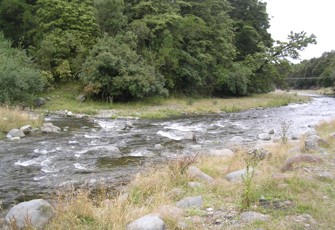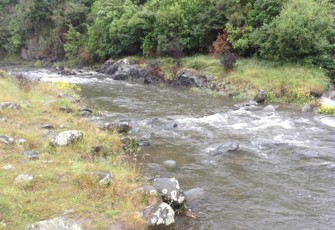The Waihi River is a hill-fed river that arises in the Four Peak Ranges. It flows south-east before eventually joining the Opihi River near Temuka.
The Waihi River at gorge site is located within a Department of Conservation (DOC) campsite.
Macroinvertebrates are collected from this site as part of Environment Canterbury's aquatic ecosystem health monitoring programme.
Instream habitat is a mix of run, riffle and pool habitat and the stream bed substrates are primarily a mix of larger gravel, cobbles and boulders. Adjacent riparian vegetation on the true left is primary native trees and on the right is mainly short grass where the camping and picnic area is.
Recreational water quality at this site is influenced by unrestricted stock access and heavy rainfall
This dashboard shows information on macroinvertebrate data collected by regional councils and unitary authorities. Select an indicator to see the available historical results.
Select a time period
- 10 years
- 15 years
State
Attribute BandTrend
Sample history at this site
What is this graph showing me?
This graph is displaying MCI scores over the selected time period. You can adjust this period by changing the dropdowns. These records for the basis for the state and trends displayed on the dashboard.
Find out about how State and Trend are calculated.
What do the attribute band icons mean?
The bands for MCI are as outlined in the National Policy Statement for Freshwater Management 2020
State
Attribute BandTrend
Sample history at this site
What is this graph showing me?
This graph is displaying QMCI scores over the selected time period. You can adjust this period by changing the dropdowns. These records for the basis for the state and trends displayed on the dashboard.
Find out about how State and Trend are calculated.
What do the attribute band icons mean?
The bands for QMCI are as outlined in the National Policy Statement for Freshwater Management 2020
State
Attribute BandTrend
Sample history at this site
What is this graph showing me?
This graph is displaying ASPM scores over the selected time period. You can adjust this period by changing the dropdowns. These records for the basis for the state and trends displayed on the dashboard.
Find out about how State and Trend are calculated.
What do the attribute band icons mean?
The bands for ASPM are as outlined in the National Policy Statement for Freshwater Management 2020
The Cawthron Institute has worked alongside regional councils to verify the processes and methods used for macroinvertebrate data collection, processing of the data in the laboratory, quality control in the field and laboratory and the statistical analysis and interpretation of the results presented.
For more details on each tick, see our 'Can I Trust this Data?' Factsheet.
Macroinvertebrates are sampled at this site as part of council's stream health monitoring programme.
Macroinvertebrate sampling is done annually or more frequently at this site. Annual sampling provides enough data points for state and trend analyses to be calculated with sufficient statistical power for trend detection.
This site is a hard-bottomed site and appropriate sampling protocols have been applied. Data shown here have been collected using current best-practice based on Stark et al. (2001).
Macroinvertebrate sampling is done in all meso-habitats (i.e., pool, run and riffle), rather than just in riffle habitat, as Stark et al. (2001) suggest. All-habitat sampling provides a more comprehensive description than riffle-only sampling of the invertebrate community at a stream site. However, comparisons made between macroinvertebrate data collected in all habitat and data collected in just riffle habitat need to be treated with caution.
This council does not collect any macroinvertebrate samples for up to two weeks after a flood greater than three times the median flow as recommended by Stark et al. (2001). Therefore, data collected at this site is following best practice.
Samples at this site have been processed following protocol P2 which is recommended by Stark et al. (2001). However, the individual count number has been reduced from 200 to 100 (with a scan for rare taxa). Data processed at this site are therefore not following best practice and conclusions based on this data need to be treated with caution.
Data collected at this site had some form of field quality control done.
Data processed at this site has had one of the three Laboratory Quality Control Protocols (i.e., QC1, QC2,Q C3) applied. Data shown here is more robust than data with no laboratory QC applied.


